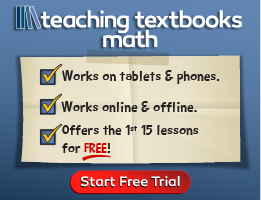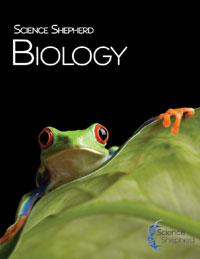As a homeschooling father, Dr. Scott Hardin realized that he and other parents were concerned about providing high-level science education to their children. He decided to create science courses for students in middle school through senior high that would raise the bar yet still be suitable for students to use independently.
Life Science and Astronomy: God’s Universe Level A can be used starting in either fifth or sixth grade. Fundamentals of Chemistry and Fundamentals of Physics can be used beginning in seventh and eighth grade and are appropriate up through tenth grade, although not as college-prep courses. In addition, high school students might choose Astronomy: God’s Universe (Level B) or Biology (which also prepares students to take the CLEP exam for college credit). Introductory Science, Earth Science, and Physical Science, which I don't discuss in this review, can be started at grade levels below middle school. The website has a Recommended Course Progression that helps parents determine when to use each course.
The courses vary in structure. All courses are either based on video lessons or offer optional, on-demand video lessons. All courses, except Biology, have workbooks with daily assignments and workbook answer keys. Life Science, Biology, Fundamentals of Chemistry, and Fundamentals of Physics have required textbooks, an Answer Key & Parent Companion book, a lab manual, tests, and answer keys. (All four textbooks are softcover and are published by Science Shepherd.)
Technically, students who need easier courses can use only videos for the four courses with textbooks, but they will not have a ready reference when they need to look something up quickly, and they won’t be fully prepared for questions and tests. I review the courses based on textbooks being a required element for those courses.
Labs are optional for all courses, but Biology has a separate lab manual and lab videos, suitable for a college-prep course. Astronomy has built-in activities within the workbooks. And the life science, chemistry, and physics courses each have lab manuals.
My reviews of representative courses follow.
Astronomy Level A and Level B
Astronomy Level A is recommended for grades five through seven, and Level B is for grades seven through nine (or above). These are typical of the Science Shepherd video-based courses without textbooks. Instruction is provided only through online videos or DVDs. Each course should take about two semesters to complete.
The two levels parallel each other, so families might use both courses with students working at different levels while covering the same topics. Level A has more than seven hours of video instruction (with videos averaging 6:30 minutes each) and is presented in 66 class sessions, with additional review sessions and optional activities. Level B has more than 11 hours of video (7:15 minutes average length) and is presented in more than 90 sessions, with additional review sessions and optional activities. The videos include illustrations and animations that help make them interesting to watch.
Each level has its own consumable workbook with a variety of worksheets and activities. Worksheets might have multiple-choice, fill-in-the-blank, and true/false questions, as well as some that require a sentence or a paragraph response. Content is sometimes written at a slightly higher Level in the workbook for Level B, and it often requires lengthier written responses. Crossword and word search puzzles are also used to reinforce lesson content. The optional activities include many that are the same for both levels, such as making flashcards for four major constellations and cutting out images of the sun and planets in our solar system and then arranging and classifying them in different ways. The Activity Supply List for both levels includes items such as binoculars, a stopwatch, a paper punch, string, and various school supplies (e.g., markers, stapler, colored pencils, paper, etc.). Each workbook has its own answer key.
A significant number of lessons address topics related to creationism from both scientific and biblical perspectives—more coverage proportionally than in other Science Shepherd science courses.
The Astronomy courses are less challenging than the other Science Shepherd courses for comparable grade levels, but they are easy to use and have great content for those who want students to learn science through a biblical worldview.
Life Science, Fundamentals of Chemistry, Fundamentals of Physics, and Biology
Life Science, Fundamentals of Chemistry, Fundamentals of Physics, and Biology share many similarities. These courses are more challenging than most others used by homeschoolers for the same grade levels. Life Science is recommended for grades 6 through 10. Fundamentals of Chemistry if for grades 7 through 10, Fundamentals of Physics is for grades 8 through 10, and Biology is for grades 9 through 12. The first three courses do not qualify as college-prep courses, since their primary audience is middle school, and Fundamentals of Chemistry and Fundamentals of Physics do not cover all topics typically taught in high school chemistry and physics courses.
The textbooks require a higher level of student attention than others, especially those for middle school. The level of difficulty might be due to the writing style. As an example, the following excerpt is from Life Science, p. 59.
As we know from the last chapter, all cells are bounded by a cell membrane that encloses the cell’s interior and protects its contents. Every cell contains smaller units, called organelles, which perform specific functions in the cell. The only organelles that prokaryotes have are ribosomes to make proteins. Ribosomes are not covered by a membrane. Eukaryotes have ribosomes and many other types of organelles. All eukaryotic organelles, except ribosomes, are covered with a membrane—a lipid bilayer just like the cell membrane. Prokaryotic and eukaryotic cells both have DNA. Prokaryotic DNA is contained in the cytoplasm in an area called the nucleoid. The DNA of eukaryotes is inside the nucleus.
According to an online reading-level calculator, this sample passage is written at tenth- or eleventh-grade level. In addition, pages are denser with print than in many other texts. The textbooks’ full-color illustrations are helpful, but these are accompanied by sometimes lengthy explanations in small fonts that also need to be read. Students who have excellent concentration and reading skills should be able to use these texts, but those weak in either area might have trouble. Consequently, the reinforcement of textbook content by videos and workbooks is very important, even though students are not required to use all course components. While the videos are not required, I think most students will wish to use them, perhaps more than the textbooks. (Textbooks are still required if students use the videos, but students might not need to read everything in the textbooks.) The videos for Life Science run for a total of more than 20 hours, those for Chemistry run more than 9 hours, Physics has more than 10 hours, and those for Biology run more than 40 hours and include the previously mentioned Biology Lab Videos. Both the course and lab videos are available via streaming through a lifetime subscription that can also be used by other students in the family.
The course textbooks all present the material similarly. Each chapter begins with a chapter preview and a brief overview. Then, each topic is taught as you would find in most textbooks. Each chapter concludes with a summary of key points, a vocabulary list with definitions, and a set of study questions for students to answer. (Note that questions are also presented in a different format via interactive online quizzes.) Each course with a textbook has a booklet of tests. Note that the Biology course doesn’t have a workbook, but it has more study questions in the textbook than other courses.
The Answer Key & Parent Companion books for Life Science, Biology, Fundamentals of Chemistry, and Fundamentals of Physics have answers to both study questions (in the textbooks) and test questions, as well as chapter summaries and Topic Questions. Topic Questions can be presented by a parent or teacher to either teach or review key ideas from most sections within each chapter—very helpful for teaching one-on-one or in groups. Suggested answers for Topic Questions are provided, so the parent or teacher need not actually read the textbooks, although that would help.
The workbooks (for Life Science, Fundamentals of Chemistry, and Fundamentals of Physics) have their own answer keys.
The combination of all the course resources provides students with thorough courses that can be used independently. The courses assess students' comprehension through workbooks, textbooks, labs, and tests and are easy for parents to oversee.
Labs
Life Science does not have a required lab component, but you can use the lab manual if you wish to make it a lab class. The videos show when to use the manual's 25 activities. Fundamentals of Chemistry and Fundamentals of Physics also have their own lab manuals, with 18 and 19 activities (respectively) that are correlated with the course content. (Answers are at the back of the books.) All three lab manuals require many resources, such as a graduated cylinder, insulated copper wire, a prism, a food thermometer, a kitchen scale, colored dish soap, and (for Life Science) a microscope. Most items can be found around the house, at a grocery store, or at a hardware store, but there are a few specialized equipment items. (Lists of supplies are on the publisher's website.)
The Biology course has a complete Biology Lab Manual with twenty labs, including dissections. These were designed to be done at home, although some equipment is needed in addition to items that can be purchased at a drug or grocery store—a microscope, slides, a dissection kit, and stains for creating slides. Science Shepherd has partnered with Rainbow Resource Center to provide a kit with all materials except the microscope and the Biology Lab Manual.
The optional Biology Lab Videos demonstrate all labs, including reproductions of slides viewed through the microscope. Students who watch the labs and complete the worksheets in the manual but don’t actually do the labs might still be able to obtain credit for a full lab course since the videos cover the steps of each lab activity. Note that the lab videos combine video and narrated PowerPoint® presentations that vary depending on the nature of the lab. Dr. Hardin explains each step slowly and clearly so it is easy for students to follow along in the lab manual. Answers to lab activities are at the back of the lab manual.
Check the publisher’s website for bundle options that include the videos with the other course components.
Evolution, Creation, and the Bible
Since Dr. Hardin is a Christian, he wanted to point out problems with the theory of evolution while still teaching students some of its core ideas. So he devotes time to the topic in each course. For example, one chapter in Life Science and three chapters in Biology address the topic. He presents both evolution and creationism as philosophies but demonstrates that creationism is more plausible than evolution. Throughout the rest of the textbooks for those two courses, the science is presented objectively without reference to either philosophy.
The Science Shepherd offers free resources related to the origins debate that include four lectures and The Genesis Worldview course with 13 video lessons.
They have also produced a book titled The Philosophy & History of Origins that can be used by high school students and adults, as well as a 15-week course, Unearthing the Bible, that reveals how archaeological discoveries continue to confirm the accuracy of the Bible.
Summary
Science Shepherd courses fit a unique niche in the homeschool market since they are designed for independent study, deal with the evolution/creation debate, and provide a lab component (to varying extents), all without requiring parental involvement beyond checking answers.










